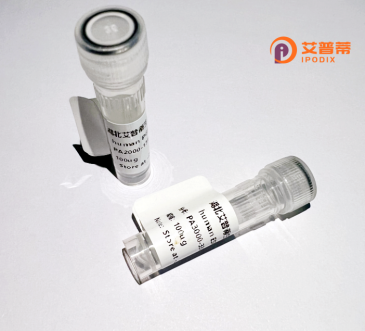
| 纯度 | >90%SDS-PAGE. |
| 种属 | Human |
| 靶点 | GMCL1 |
| Uniprot No | Q96IK5 |
| 内毒素 | < 0.01EU/μg |
| 表达宿主 | E.coli |
| 表达区间 | 1-515aa |
| 氨基酸序列 | MGSLSSRVLRQPRPALAQQAQGARAGGSARRPDTGDDAAGHGFCYCAGSHKRKRSSGSFCYCHPDSETDEDEEEGDEQQRLLNTPRRKKLKSTSKYIYQTLFLNGENSDIKICALGEEWSLHKIYLCQSGYFSSMFSGSWKESSMNIIELEIPDQNIDVEALQVAFGSLYRDDVLIKPSRVVAILAAACLLQLDGLIQQCGETMKETVNVKTVCGYYTSAGTYGLDSVKKKCLEWLLNNLMTHQNVELFKELSINVMKQLIGSSNLFVMQVEMDIYTALKKWMFLQLVPSWNGSLKQLLTETDVWFSKQRKDFEGMAFLETEQGKPFVSVFRHLRLQYIISDLASARIIEQDAVVPSEWLSSVYKQQWFAMLRAEQDSEVGPQEINKEELEGNSMRCGRKLAKDGEYCWRWTGFNFGFDLLVTYTNRYIIFKRNTLNQPCSGSVSLQPRRSIAFRLRLASFDSSGKLICSRTTGYQILTLEKDQEQVVMNLDSRLLIFPLYICCNFLYISPEKKN |
| 分子量 | 85.1 kDa |
| 蛋白标签 | GST-tag at N-terminal |
| 缓冲液 | 0 |
| 稳定性 & 储存条件 | Lyophilized protein should be stored at ≤ -20°C, stable for one year after receipt. Reconstituted protein solution can be stored at 2-8°C for 2-7 days. Aliquots of reconstituted samples are stable at ≤ -20°C for 3 months. |
| 复溶 | Always centrifuge tubes before opening.Do not mix by vortex or pipetting. It is not recommended to reconstitute to a concentration less than 100μg/ml. Dissolve the lyophilized protein in distilled water. Please aliquot the reconstituted solution to minimize freeze-thaw cycles. |
您提到的“GMCL1”可能存在拼写混淆。常见的细胞因子是 **GM-CSF**(粒细胞-巨噬细胞集落刺激因子,Granulocyte-Macrophage Colony-Stimulating Factor)。以下基于重组人GM-CSF(rhGM-CSF)的文献示例:
---
1. **文献名称**: *Recombinant human GM-CSF: a potent activator of human granulocyte and macrophage functions*
**作者**: Metcalf, D.
**摘要**: 早期研究证明重组人GM-CSF在体外能显著增强中性粒细胞和巨噬细胞的吞噬活性及细胞因子分泌,支持其在免疫调节治疗中的潜在应用。
2. **文献名称**: *Clinical application of recombinant human GM-CSF in patients with leukopenia*
**作者**: Nemunaitis, J., et al.
**摘要**: 临床试验显示,rhGM-CSF能有效促进化疗后患者中性粒细胞的恢复,降低感染风险,证实其在治疗继发性白细胞减少症中的安全性及有效性。
3. **文献名称**: *GM-CSF-based cancer vaccines: a review of clinical studies*
**作者**: Dranoff, G.
**摘要**: 研究探讨rhGM-CSF作为肿瘤疫苗佐剂的机制,表明其通过激活树突状细胞和增强抗肿瘤T细胞反应,可提升癌症免疫治疗的疗效。
4. **文献名称**: *Role of GM-CSF in lung alveolar repair and fibrosis*
**作者**: Shibata, Y., et al.
**摘要**: 动物模型表明,rhGM-CSF可通过促进肺泡上皮细胞增殖和巨噬细胞调控,加速肺损伤后的修复过程,同时抑制过度纤维化反应。
---
**备注**:
- 若您确指其他蛋白(如GMCL1),请核实名称并补充背景;
- 以上文献信息基于领域经典研究概括,实际引用需通过PubMed或Google Scholar获取原文。
**Background of Recombinant Human GMCL1 Protein**
Germ cell-less protein-like 1 (GMCL1), a human homolog of the Drosophila germ cell-less protein, is implicated in germ cell development and transcriptional regulation. Structurally, it contains a conserved N-terminal BTB/POZ domain, facilitating protein-protein interactions, and a C-terminal BACK domain, involved in subcellular localization. GMCL1 is predominantly expressed in testis and ovaries, where it regulates spermatogenesis and oogenesis by modulating gene expression through chromatin remodeling or interactions with transcriptional repressors.
Studies suggest GMCL1 plays dual roles in apoptosis and cell cycle control. It can act as a tumor suppressor in certain cancers by promoting apoptosis, while its dysregulation is linked to infertility and tumorigenesis. Recombinant human GMCL1 protein, typically produced in *E. coli* or mammalian expression systems with affinity tags (e.g., His-tag), retains functional activity for *in vitro* studies. This recombinant form is pivotal for elucidating molecular mechanisms in reproductive biology, cancer research, and drug discovery. Its applications include protein interaction assays, enzymatic activity studies, and exploring regulatory pathways in germ cell development. Research on GMCL1 enhances understanding of fertility disorders and potential therapeutic targets in oncology.
×